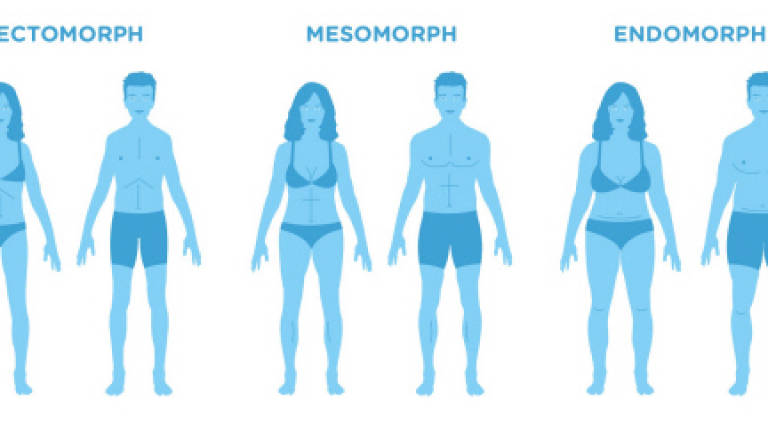Morphing into better physique

EACH person is unique. At least, this is what we've been led to believe.
In truth, people fall into combinations of three basic body types: endomorph, mesomorph, and ectomorph.
An American psychologist named William H. Sheldon first introduced this concept of body types, or somatotypes, in the 1940s.
Since then, nutritionists, exercise physiologists, and even doctors have used his theories to help design effective, individualised fitness plans.
Our own body type has been mostly predetermined by our genetics. If your mum and dad are tall, you and your siblings will most likely be tall too.
Is there then a justification for saying that because your family is on the heavy side, therefore, you are "naturally big-boned"?
The fact is, genetics does play a huge role in determining the way we look, but scientists have proved that our environment and lifestyle can influence our bodies.
For example, better nutrition and healthcare have made several centimetres taller than our ancestors were three or four generations ago.
Each body type has its own set of physical and psychological traits.
Ectomorph
Ectomorphs are generally long, slender, and thin-looking, with narrow shoulders and hips, as well as a narrow chest and abdomen.
They have thin arms and legs, and very little muscle and fat on their body.
While they can easily get lean, their lack of musculature severely limits their chances in power and strength sport, which require participants with a lot of mass.
Their very low levels of body fat can also be detrimental to health. For females, this can result in a cessation of periods and iron deficiency.
Ectomorphs usually are best suited to endurance sport. Their smaller, lighter body is better at thermo regulation, which is important in endurance-based sport like marathon running.
Their light frame also makes them ideal for aerobic activity. Long distance running, cycling, and aerial track and field events like the long jump and high jump are some of the activities associated to people with these body types.
Mesomorph
Mesomorphs have a wedge-shaped body with wide broad shoulders, muscled arms and legs, and narrow hips. These make them excel in activities that involve strength, agility, and speed.
Their medium structure and height, along with their tendency to gain muscle and strength easily, make them a strong candidate to become a top athlete in any sport.
They can sustain low body fat levels, and find it easy to both lose and gain weight.
With a lighter frame, mesomorphs respond well to cardiovascular and resistance training.
And because they can sustain fluctuating body fat levels, they can cope with rigorous and intensive training programmes which often see athletes having to gain or lose weight within a set time.
However, mesomorphs can swing both ways, from fat to skinny and back, if they are not watching their diet or exercise.
This body type is also called the 'muscular build', because all muscle groups can easily adapt to exercise.
Endomorph
Endomorphs are usually characterised by a pear-shaped body, wide hips, and strong thighs and shoulders.
Their bodies tend to look flat from the front, and narrow from the side.
Endomorphs also pack a lot of fat on the body, upper arms and thighs. As such, they typically have short arms and legs, and a large amount of mass on their frame.
This mass hampers their ability to compete in sport requiring high levels of agility or speed.
However, activities that require pure strength are perfect for endomorphs.
They can gain weight easily, but also are in danger of losing most of their muscle mass if they stop their training.
Endomorphs excel in sport requiring a lot of mass, such as rugby, provided it can be moved powerfully.
Their large frame tends to have a larger lung capacity, which also suits other sport that require short, powerful bursts of energy, such as rowing and power lifting.
Ectomorphs usually have good appetites. This comes from having to fuel their naturally larger frames.
Thus a certain degree of mindful eating control is needed to not put on excess body fat.
Clearly most people start a programme of exercise because they fit into one of these categories.
The ectomorph probably yearns to be fitter and meatier, the mesomorph wants to look better, and the endomorph wants to lose weight.
Unfortunately, this wide use of somatotyping has provided a lot of excuses for people to explain why fat people 'can't' lose weight, or why skinny people 'can't' put on muscle, or why the people who can do those things have only their genetics to thank for it – and not because of their diligence and hard work.
And while you can dramatically change your somatotype via exercise and proper diet, that is only if your body type is an in-between.
So most likely, that rake-thin friend you use to know in school will still look like that in 30 years, just with a bigger belly and meatier limbs.
Somatotyping only serves as a guideline. Those who are stronger, more muscular, and more ripped than you have gotten that way because they spend less time feeling sorry for themselves, and more time lifting weights and running.
There is absolutely no reason why you can't change your health, body, and quality of life today. Now get off your butt and go do something awesome.
Let's be fit!
Jonathan Tan is the club manager of the Sports Toto Fitness Centre at Berjaya Times Square. He can be contacted at lifestyle.jonathan@thesundaily.com.